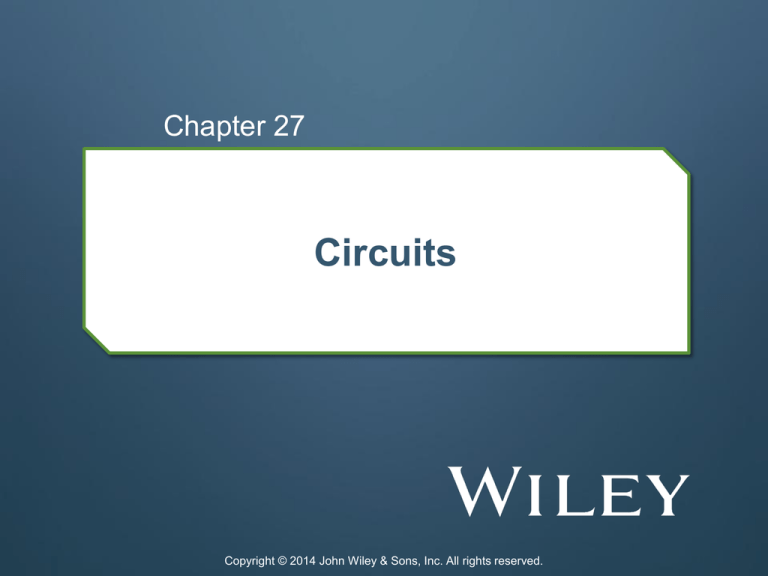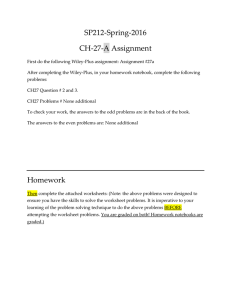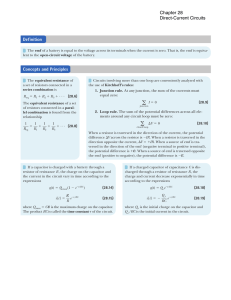
Chapter 27
Circuits
Copyright © 2014 John Wiley & Sons, Inc. All rights reserved.
27-1 Single-Loop Circuits
To produce a steady flow of charge, you need a “charge pump,” a device that—
by doing work on the charge carriers—maintains a potential difference between
a pair of terminals. We call such a device an emf device, and the device is said
to provide an emf , which means that it does work on charge carriers.
Figure shows an emf device (consider it to
be a battery) that is part of a simple circuit
containing a single resistance R. The emf
device keeps one of its terminals (called
the positive terminal and often labeled +) at
a higher electric potential than the other
terminal (called the negative terminal and
labeled -). We can represent the emf of the
device with an arrow that points from the
negative terminal toward the positive
terminal as in Figure. A small circle on the
tail of the emf arrow distinguishes it from
the arrows that indicate current direction.
© 2014 John Wiley & Sons, Inc. All rights reserved.
27-1 Single-Loop Circuits
An emf device does work on charges to maintain a potential difference between
its output terminals. If dW is the work the device does to force positive charge
dq from the negative to the positive terminal, then the emf (work per unit
charge) of the device is
An ideal emf device is one that lacks any
internal resistance. The potential difference
between its terminals is equal to the emf.
A real emf device has internal resistance.
The potential difference between its
terminals is equal to the emf only if there is
no current through the device.
© 2014 John Wiley & Sons, Inc. All rights reserved.
27-1 Single-Loop Circuits
Calculating Current in a Single-Loop Circuits
Energy Method
Equation, P=i2R, tells us that in a time interval dt an amount of energy given
by i2R dt will appear in the resistor (shown in the figure) as thermal energy.
This energy is said to be dissipated. (Because we assume the wires to have
negligible resistance, no thermal energy will appear in them.)
During the same interval, a charge dq = i dt will have
moved through battery B, and the work that the battery
will have done on this charge is
From the principle of conservation of energy, the work
done by the (ideal) battery must equal the thermal energy
that appears in the resistor:
Which gives us
© 2014 John Wiley & Sons, Inc. All rights reserved.
27-1 Single-Loop Circuits
Calculating Current in a Single-Loop Circuits
Potential Method
In the figure, let us start at point a, whose potential is Va, and mentally walk
clockwise around the circuit until we are back at point a, keeping track of
potential changes as we move. Our starting point is at the low-potential
terminal of the battery. Because the battery is ideal, the potential difference
between its terminals is equal to . When we pass through the battery to the
high-potential terminal, the change in potential is + .
After making a complete loop, our initial potential, as
modified for potential changes along the way, must be
equal to our final potential; that is,
The value of Va cancels from this equation, which
becomes
Which gives us
© 2014 John Wiley & Sons, Inc. All rights reserved.
27-1 Single-Loop Circuits
Calculating Current in a Single-Loop Circuits
© 2014 John Wiley & Sons, Inc. All rights reserved.
27-1 Single-Loop Circuits
Internal Resistance
Figure (a) shows a real battery, with internal resistance r, wired to an external
resistor of resistance R. The internal resistance of the battery is the electrical
resistance of the conducting materials of the battery and thus is an un removable
feature of the battery. Figure (b) shows graphically the changes in electric potential
around the circuit. Now if we apply the loop rule clockwise beginning at point a, the
changes in potential give us
Solving for the current we find,
© 2014 John Wiley & Sons, Inc. All rights reserved.
27-1 Single-Loop Circuits
Resistance in Series
Figure (a) shows three resistances connected in series to an
ideal battery with emf . The resistances are connected one
after another between a and b, and a potential difference is
maintained across a and b by the battery. The potential
differences that then exist across the resistances in the series
produce identical currents i in them. To find total resistance
Req in Fig. (b), we apply the loop rule to both circuits. For Fig.
(a), starting at a and going clockwise around the circuit, we
find
or
For Fig. (b), with the three resistances replaced with a single
equivalent resistance Req, we find
or
Equating them, we get,
© 2014 John Wiley & Sons, Inc. All rights reserved.
27-1 Single-Loop Circuits
Resistance in Series
Answer: (a) current is same for all resistors in series.
(b) V1 , V2 , and V3
© 2014 John Wiley & Sons, Inc. All rights reserved.
27-1 Single-Loop Circuits
Potential Difference
Potential Difference across a real battery: In the Figure,
points a and b are located at the terminals of the battery.
Thus, the potential difference Vb - Va is the terminal-toterminal potential difference V across the batter and is
given by:
Grounding a Circuit: Grounding a circuit usually means connecting one point in
the circuit to a conducting path to Earth’s surface (actually to the electrically
conducting moist dirt and rock below ground)
Power of emf Device: The rate Pemf at which the emf device transfers energy both
to the charge carriers and to internal thermal energy is
© 2014 John Wiley & Sons, Inc. All rights reserved.
27-2 Multiloop Circuits
Figure shows a circuit containing more than one
loop. If we traverse the left-hand loop in a
counterclockwise direction from point b, the loop
rule gives us
If we traverse the right-hand loop in a counterclockwise direction from point
b, the loop rule gives us
If we had applied the loop rule to the big loop, we would have obtained
(moving counterclockwise from b) the equation
which is the sum of two small loops equations.
© 2014 John Wiley & Sons, Inc. All rights reserved.
27-2 Multi-Loop Circuits
Resistances in Parallel
Figure (a) shows three resistances
connected in parallel to an ideal battery of
emf . . The applied potential difference V
is maintained by the battery. Fig. b, the
three parallel resistances have been
replaced with an equivalent resistance Req.
To derive an expression for Req in Fig. (b), we first write the current in each
actual resistance in Fig. (a) as
where V is the potential difference between a and b. If we apply the junction
rule at point a in Fig. (a) and then substitute these values, we find
If we replaced the parallel combination with the equivalent resistance Req
(Fig. b), we would have
and thus substituting the value of i from
above equation we get,
© 2014 John Wiley & Sons, Inc. All rights reserved.
27-2 Multi-Loop Circuits
Resistance and capacitors
Answer: (a) Potential difference across each resistor: V/2
Current through each resistor: i
(b) Potential difference across each resistor: V
Current through each resistor: i/2
© 2014 John Wiley & Sons, Inc. All rights reserved.
27-3 The Ammeter and The Voltmeter
An instrument used to measure currents is called an
ammeter. To measure the current in a wire, you usually
have to break or cut the wire and insert the ammeter so
that the current to be measured passes through the meter.
In the figure, ammeter A is set up to measure current i. It
is essential that the resistance RA of the ammeter be very
much smaller than other resistances in the circuit.
Otherwise, the very presence of the meter will change the
current to be measured.
A meter used to measure potential differences is called a voltmeter. To find the
potential difference between any two points in the circuit, the voltmeter terminals are
connected between those points without breaking or cutting the wire. In the Figure,
voltmeter V is set up to measure the voltage across R1. It is essential that the
resistance RV of a voltmeter be very much larger than the resistance of any circuit
element across which the voltmeter is connected. This is to insure that only a
negligible current passes through the voltmeter, otherwise, the meter alters the
potential difference that is to be measured.
© 2014 John Wiley & Sons, Inc. All rights reserved.
27-4 RC Circuits
Charging a capacitor: The capacitor of capacitance C in
the figure is initially uncharged. To charge it, we close
switch S on point a. This completes an RC series circuit
consisting of the capacitor, an ideal battery of emf , and a
resistance R.
The charge on the capacitor increases according to
Figure: RC circuit
in which C = q0 is the equilibrium (final) charge and RC=τ
is the capacitive time constant of the circuit. During the
charging, the current is
The plot shows the buildup
of charge on the capacitor of
the above figure.
And the voltage is:
The product RC is called the capacitive time constant of
the circuit and is represented with the symbol τ.
© 2014 John Wiley & Sons, Inc. All rights reserved.
27-4 RC Circuits
Discharging a capacitor: Assume now that the capacitor
of the figure is fully charged to a potential V0 equal to the
emf of the battery. At a new time t=0, switch S is thrown
from a to b so that the capacitor can discharge through
resistance R.
When a capacitor discharges through a resistance R, the
charge on the capacitor decays according to
Figure: RC circuit
where q0 (=CV0) is the initial charge on the capacitor.
During the discharging, the current is
A plot shows the decline of
the charging current in the
circuit of the above figure.
© 2014 John Wiley & Sons, Inc. All rights reserved.
26 Summary
Emf
Series Resistance
• The emf (work per unit charge) of
the device is
• When resistances are in series
Eq. 27-7
Eq. 27-1
Parallel Resistance
Single-Loop Circuits
• Current in a single-loop circuit:
• When resistances are in parallel
Eq. 27-24
Eq. 27-4
Power
• The rate P of energy transfer to the
charge carriers is
Eq. 27-14
• The rate Pr at which energy is
dissipated as thermal energy in the
battery is
Eq. 27-16
• The rate Pemf at which the chemical
energy in the battery changes is
Eq. 27-17
RC Circuits
• The charge on the capacitor
increases according to
Eq. 27-33
• During the charging, the current is
Eq. 27-34
• During the discharging, the current
is
Eq. 27-40
© 2014 John Wiley & Sons, Inc. All rights reserved.





